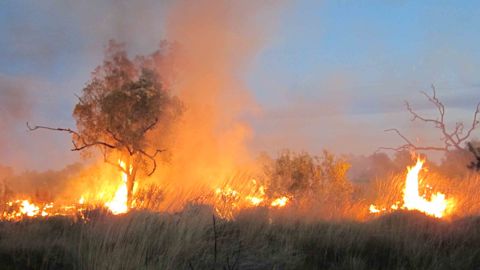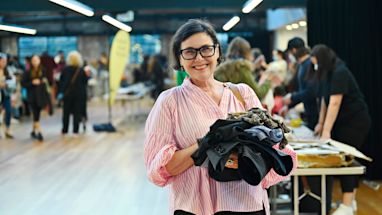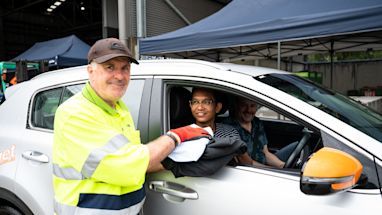Australia’s Black Summer—our devastating 2019-20 bushfire season—highlighted the symptoms of climate change and led to strong interest in Aboriginal cultural fire stick farming practices. Fortunately, it’s now possible to invest in fire stick farming, also known as cultural burning, by purchasing carbon offsets.
What fire stick farming involves
Fire stick farming is a way of managing the environment Aboriginal communities have practiced for tens of thousands of years.
It improves the health of the land and wildlife by setting cool burns, generally spot fires with smaller, more controlled flames during the early, cool dry season.
This helps prevent the build-up of vegetation that leads to the larger, hotter, uncontrolled fires of Australia’s scorching months.
Larger, hotter, fires emit more carbon emissions than cool burns.
So cultural burning reduces carbon emissions—the release of strong greenhouse gases into our atmosphere.

It’s not only about preventing raging fires
Reducing vegetation that’s likely to fuel uncontrollable fires is only one aim.
Fire stick farming also supresses weeds and improves conditions for native wildlife, plants and grasses.
It’s also used to create or clear pathways to gain better access to Country for cultural purposes.
Trained Elders carry out the cool burns. The techniques used vary from region to region to suit the specific environmental conditions present.
Practitioners constantly listen to the environment - the habitat, vegetation, soil, moisture levels and more - to determine when, where, and how hot the burn will be.
Providing income opportunities in northern Australia
Currently, most fire stick farming occurs in the NT, northern QLD and northern WA. In 2018, for example, there were nearly 80 cultural burns across savannas in northern Australia.
From an offsetting perspective, this form of land management is really catching on: burn projects comprised 10% of Australian carbon offsets in 2019.
And each one of these programs provides environmental, economic, social and cultural benefits. Among them, experts estimate that fire management offsets provide around $15 million annually to local economies.
How we got involved
In early 2020, we began investigating options for purchasing ethically sourced offsets from fire stick farmers, also known as carbon farmers, in northern Australia.
After some research and discussions, we chose to partner with the Aboriginal Carbon Foundation, an Indigenous not-for-profit that supports carbon projects and maintains an office in Sydney.
The organisation has Indigenous rangers at its helm and connects Aboriginal communities with organisations seeking to offset their emissions.
“This important partnership highlights the City of Sydney’s commitment to our Indigenous economic development plan by continuing to procure from Aboriginal and Torres Strait Islander businesses for our needs,” Senior community engagement coordinator, Indigenous lead David Beaumont said.
Working with the Aboriginal Carbon Foundation, we chose to buy Australian Carbon Credit Units from the Tiwi Islands savanna burning for greenhouse gas abatement project.
The Tiwi Islands are part of the NT, 80km to the north of Darwin adjoining the Timor Sea.
NSW projects on the horizon
As proud Sydneysiders, we would ideally like to work with local Aboriginal organisations in NSW. But there are currently no accredited offsets for fire stick farming in our state.
Currently, Climate Active recognises only fire stick farming offsets from the northern Australian savanna burning projects.
There’s good news though. With enough demand, the Aboriginal Carbon Foundation is willing to create a supply of carbon offset projects throughout NSW.
“Sydney residents supporting Traditional Owners cool burning of Country is excellent. It’s the way to alleviate hot bushfires late in the dry season and reduces greenhouse gas emissions,” Aboriginal Carbon Foundation Chief Executive Officer Rowan Foley said.
“Carbon credits produced on Aboriginal lands using the savanna burning methodology is good for biodiversity and jobs for Aboriginal rangers. We’re keen to facilitate fire stick farming projects in NSW.”
Purchasing offsets is an important part of our emissions reduction plan, but by no means the only action we’re taking.
We switched to buying 100% renewable electricity last year.
We’ve installed more than 7,000 solar panels on our properties, along with a massive Tesla battery at our Alexandria depot.
And we continue to reduce the electricity we use by increasing the energy efficiency of our facilities.
We purchase offsets for the emissions we simply can’t avoid.
How you can get involved
We can work with other councils and corporations to increase demand, but there’s a significant role for businesses and other organisations too.
Buying carbon offsets from the Aboriginal Carbon Foundation is a simple, effective way for you to positively impact our country and planet.
Though carbon offsets are intangible, they generate many tangible benefits. For example, in putting your carbon offsets towards fire stick farming projects, you are:
- compensating for your emissions and helping kick off projects like these
- mitigating the chance of large bushfires and their devastating effects
- improving natural biodiversity
- helping the environment through Indigenous-led land management
- creating meaningful employment for Aboriginal communities
- supporting Aboriginal communities to explore new industries
- investing in local economies
- protecting significant sites
- keeping these cultural practices alive for future generations.
Fire stick farming and carbon offset programs are useful tactics for combating climate change.
They offer a positive and powerful way forward through the climate emergency. Spread the word.
If you have any questions about buying carbon offsets, or working with the Aboriginal Carbon Foundation, email us at renewableenergy@cityofsydney.new.gov.au.
We’d like to help.
Useful links:
Published 11 March 2021



